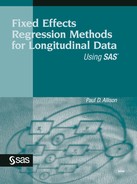5.4. Some Caveats
Despite the attractions of fixed effects Cox regression, it also has the usual disadvantages. As with other fixed effects methods we've employed, there may be a substantial loss of power compared with the conventional analysis. In this example, any woman with only one birth interval gets excluded because that interval can't be compared with any others. This eliminates 2,109 birth intervals. Second, among women with exactly two birth intervals, if the second interval (which is always censored) is shorter than the first, both intervals will be excluded. Here's why. Suppose the first interval is 28 months long, and the second interval is censored at 20 months. In constructing the partial likelihood for the birth that occurs at 28 months, the algorithm looks for other intervals (from the same woman) that are at risk of the event at that same time. But if the only other interval was censored at 20 months, the woman is no longer at risk of an observable birth at 28 months. As a result, there is nothing with which to compare the birth, and the woman is eliminated from the partial likelihood function. For the NSFG data, the elimination of these intervals results in the loss of another 1,468 cases.
Finally, even for those observations that are retained, the fixed effects method essentially discards information about variation across women and only uses variation within women. So if a particular covariate varies a great deal across women, but shows little variation over time for each woman, the coefficient for that variable will be poorly estimated. The variable PASST, for example, has 80% of its variance across women and only 20% within women. Not surprisingly, the standard error for its coefficient is more than twice as large in Output 5.3 as compared with Output 5.2, which was based on variation both within and between women.
Besides the usual limitations of fixed effects methods, fixed effects Cox regression is also susceptible to bias for certain kinds of variables. These problems are most likely to occur with the kind of data structure that occurs in the birth interval study. In that structure, individuals are observed for a fixed period of time and may have multiple events during that period, but only the last interval is censored. Chamberlain (1985) argued that this structure violates a basic condition of likelihood-based estimation because the probability that an interval is censored depends on the length of the previous intervals.
In a simulation study (Allison 1996), I showed that this violation does not create a serious problem for most predictor variables, but could lead to biases in estimating the effects of variables that describe the previous event history. In particular, fixed effects partial likelihood tends to find negative effects on the hazard for the number of previous events and the length of the previous interval, even when those variables do not have true effects. This is certainly consistent with the results in Outputs 5.3 and 5.4, which show strong negative effects of pregnancy order on the hazard of a subsequent birth. We should be very cautious in interpreting those effects, because they could potentially be an artifact of the method. This problem tends to be most severe when the average number of events per individual is low, and the proportion of intervals that are censored is high.
